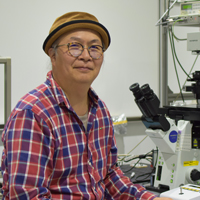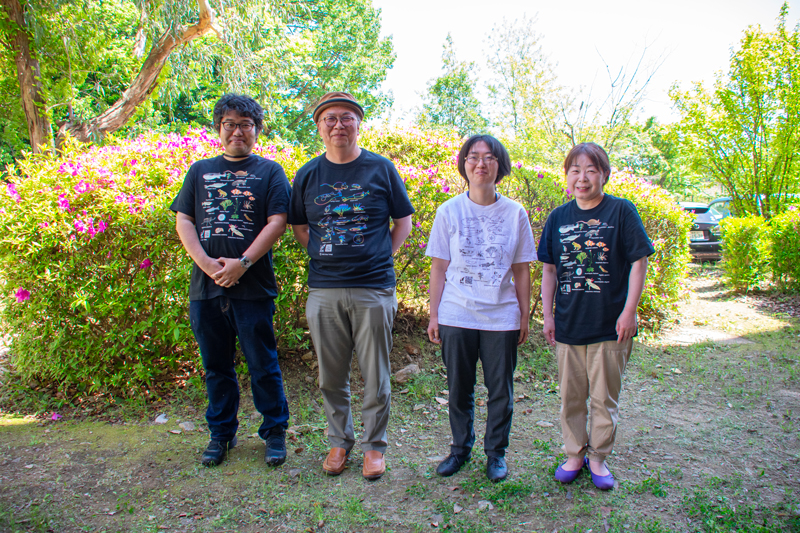-Aiming to elucidate the biological significance of heat and temperature-
Temperature is one of the important parameters for living organisms, and living organisms inhabit various environmental temperatures. However, the temperature on the nanoscale has not been discussed so far. Recently, nano-scale thermometers utilizing fluorescent proteins and dyes were developed by some research groups, and they reported heterogeneity of temperature in the microenvironment of living cells, respectively. Our group has an original technology, IR-LEGO which can regulate spatiotemporal gene expression by local heating and heat shock response. By using the local heating and temperature imaging microscopic technology, we drive into a new field, thermobiology, through investigating the nature of temperature for living organisms from nano to macro.
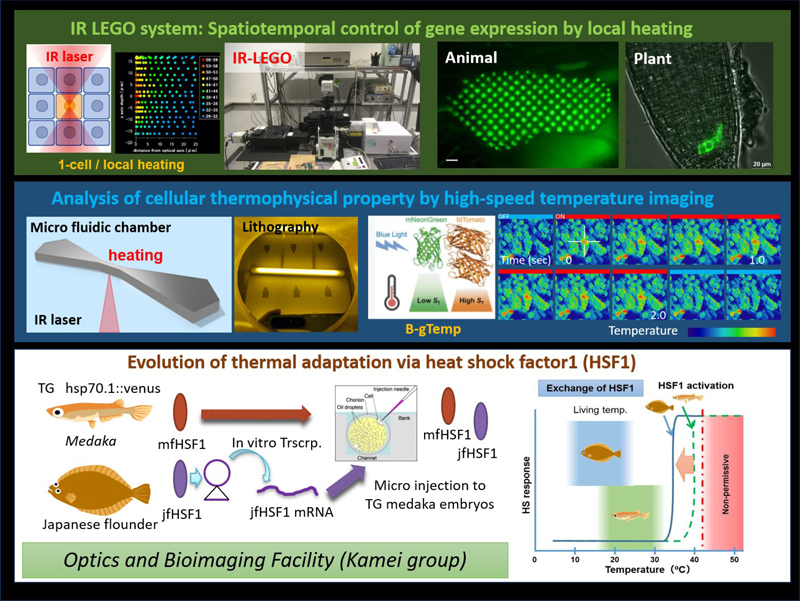
Our original microscopic and biological technology of heat shock response, temperature indicators and high-speed imaging will open a new field of biology.
Research Projects
-
• Analysis of cellular thermophysical properties by microfabrication and microscopic technologies.
-
• Evolution of thermal adaptation via heat shock response and its application to the new IR-LEGO system.
Temperature is an important parameter for living organisms. Cell activity is affected by temperature since the reaction ratio and stability of molecules, especially proteins in cells, depends on it. The environmental temperature which organisms function in vary, and the biological system that regulates body temperature, homeostasis, differs among various organisms. Furthermore, temperatures in either cells or at the molecular level have not been widely discussed to date. Nano-scale ther-mometers utilizing fluorescent proteins and dyes have been developed by numerous research groups including our own, and heterogeneity of temperatures in the micro environments of living cells have been reported on by said groups (Okabe
et al, Nat Commun 2014, Kiyonaka
et al, Nat. Methods 2014, and Nakano
et al, PLoS One 2017). However, the meaning and mechanisms involved in single cells remain unclear. Therefore, our group is embarking upon a new research field, biothermology, by investigating the nature of temperature in living organisms ranging from nano to macro.
Our research group employs various and original biother-mological research technologies. One of these is the infrared (IR) laser application, which enables single-cell or subcel-lular local heating by focusing IR through an objective lens on a microscope This technology was originally developed for laser induced gene expression in the targeting of single-cells through the heat shock response, IR-LEGO: InfraRed Laser Evoked Gene Operator (Kamei
et al, Nat. Methods 2009) (Figure 1). This local heating technique can be used to analyze the thermodynamics of a cell via the use of a nano-scale thermometer; the second of our abovementioned original techniques. To analyze temperature distribution at subcellular resolutions, a nano-scale thermometer is required. For this reason, we have focused on fluorescent proteins, and developed a genetically encoded thermometer, the so called gTEMP, with Dr. Takeharu Nagai from Osaka University (Nakano
et al, PLoS One 2017). This thermometer has some unique properties, such as rapid responsiveness and applica-bility to wide temperature range. By utilizing this thermom-eter, we are developing a high-speed thermal imaging micro-scope system combined with IR irradiation optics. Through the analysis of thermal dynamics in cells, we are trying to reveal how temperature heterogeneity is generated within a single cell as well as considering its meaning from a biologi-cal standpoint.
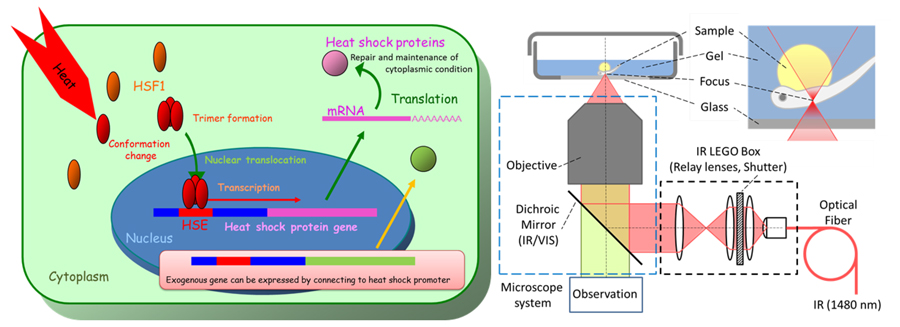
Figure 1. Schematic illustration of heat shock response of cells (left) and an infrared laser-evoked gene operator (IR-LEGO) microscope system.
Furthermore, our group is trying to improve the IR-LEGO technique. We initially applied this system to many organ-isms including animals (
i.e. medaka, nematode, flies and frogs) and plants (
i.e. Araidopsis moss in collaborative research projects in cooperation with other laboratories. Because the heat shock response (HSR) is a transient response, gene expressions after IR-LEGO operation are also transient. Despite this, some of our collaborators wanted to realize cell fate mapping, which requires a long-term gene expression after IR irradiation. Accordingly, we employed the Cre/LoxP recombination system. As shown in Figure 2, we established a cre driver line, which possesses a heat shock promoter and loxP effector line which can permanently label irradiated cell lineages by utilizing fluorescent proteins. By using these transgenic lines, evidence was provided that indi-cated that exoskeletal tissues in the trunk region came from the mesoderm (Shimada
et al, Nat Commun. 2013).
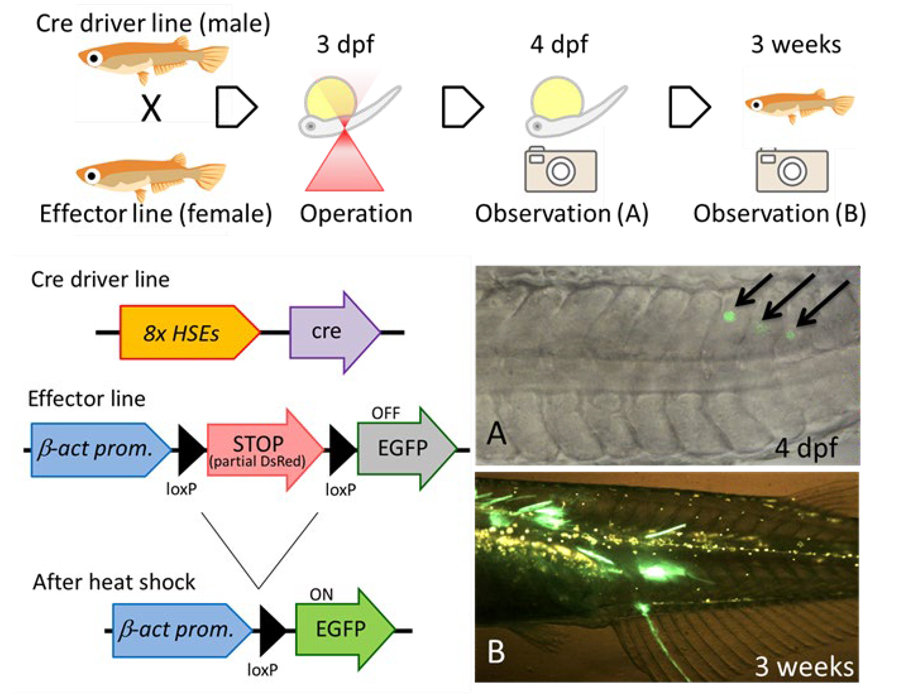
Figure 2. Long-term gene expression system with cre/loxP recombination system and an example of a practical experiment in medaka ranging embryos to adults.
The HSR is a conservative stress response system found in almost all organisms. In contrast, organisms live in various temperatures, and HSR essentially is the upper limit of habit-able temperature range for each organism. This means that the preset temperature of HSR may differ among organisms. A key factor of this limitation is heat shock factor 1 (HSF1); a homologue within each organism. By substituting HSF1, it may be possible to control the preset temperature of HSR, and this substitution could be applied to the improvement of HSR efficiency in IR-LEGO technology. We are now trying to lower the HSR temperature of medaka by substituting Japanese flounder HSF1. The HSF1 substitution provides us with various types of significant information and evidence related to molecular evolution and adaptation to environmen-tal temperature. Thus, this is how this project also contributes to the study of biothermology.
We also promote other collaborative studies using micro-scopic techniques. One is a “clear observation project” for deep seeing into living organisms using adaptive optics (AO), which have been thoroughly developed in the field of astronomy as a key technology found in large telescopes, such as the Subaru telescope in Hawaii. Although observa-tion using Earth based telescopes may be interfered with due to fluctuations in the atmosphere, AO can mitigate this. However, living materials have particular refractive indexes, so some organelles may hinder the ideal optical path for microscope observation, which is similar to the situation that exists regarding the atmosphere and telescopes. AO can also compensate for this disturbance by sensing and correcting wave fronts by using a wave front sensor and deformable mirror. Hence, we have developed a custom-made wide-field microscope equipped with an AO system for the observation of living organisms in collaboration with Dr. Yosuke Tamada from Utsunomiya University and Dr. Yutaka Hayano from the National Astronomical Observatory of Japan (NAOJ). By utilizing this microscopic system, we have successfully acquired high-resolution bright field and fluorescent images of living cells. Furthermore, AO can also be applied to IR-LEGO technology to improve IR energy focusing of irra-diation in a manner similar to improving the sight of living organisms.





